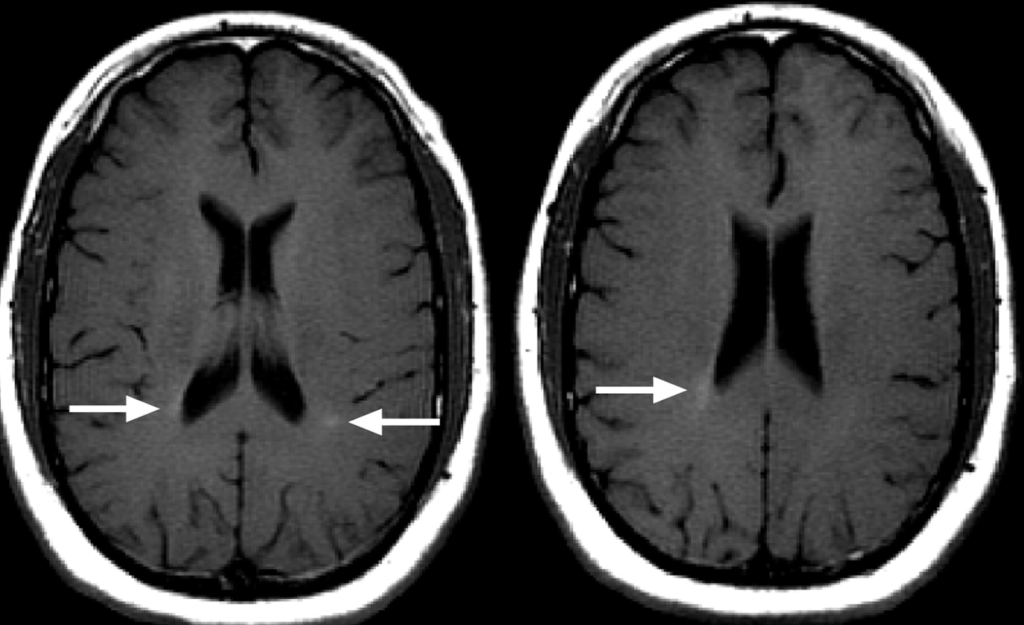The non-pharmaceutical, structural treatment of Multiple Sclerosis (MS) is somewhat controversial. Is there a more natural, alternative treatment for MS? That is both effective and safe and scientifically sound? To answer, I remember nearly 25 years ago taking on a young female patient who had recently been diagnosed with multiple sclerosis, or MS by a neurologist. She was 19 years old. This new diagnosis that she was given was a heavy burden to bear as she told me that she saw her life coming to an end. Treatment results were sketchy, and expensive. (Something only big Pharma and Madison Avenue could legitimize) She was in tears when she revealed to me that the neurologist had recently looked at her MRI, had observed tiny white plaques in her brain and had told her rather candidly that the reason she had her symptoms was because she had MS. She told me that these white spots in her brain tissue, which her neurologist had identified as multiple sclerosis, lesions, or MS Signs were also in her upper cervical spinal cord.
Her symptoms, which led her to her family doctor, who then referred her to a neurologist, were varied. She was experiencing numbness and tingling in her hands and legs, along with some shooting electrical pains which were growing more frequent. These pains would shoot like electrical jolts down into her hands and arms and legs. She also struggled with migraines along with difficulty in remembering things. She said her balance had become really unsteady. My heart broke as I looked at this young woman who was at the beginning of her life, and watching her attempts at coming to terms with a diagnosis as formidable as multiple sclerosis.
In order to look at her MRI’s–at this time we did not have electronic images that could be pulled up on a digital screen–we had to place big sheets of film on an illuminated view box and look at the slices one by one. She had brought the images into my office to show me and had asked for my humble second opinion. I could see little white specks around her ventricles.

A few of these spots were circled in a red sharpie marker by her neurologist. There were also small white spots visible in the upper cervical spinal cord. But I saw something else too. As I looked at her images, I noticed that the top bone of her spine, the atlas, was slightly tilted on the front facing view of the MRI, and seemed also to be twisted under her skull when looking at a perpendicular view. I also noticed that the axis vertebra that supports the atlas was twisted in the opposite direction. I pointed this out to her, and said I was hopeful that I could reposition that vertebra and at least help with her headaches and balance issues–and maybe with the electrical jolting symptoms because I had helped people with those symptoms before.
At the time I had no real experience with Multiple Sclerosis (MS) patients, and I didn’t know what to expect, but had quite favorable outcomes with patients that had many of her symptoms. I looked at multiple sclerosis as a sort of life sentence–and did not expect to fix anything there. The young woman agreed to proceed with treatment, and we obtained other imaging in my clinic that was needed for me to reposition her atlas to an aligned position. We performed the procedure the next day, and we were both encouraged following the procedure as her migraine immediately went away.
When I saw her a week later for a follow up on the alternative MS treatment process, the expression on her face had dramatically changed. Her countenance was more bright and relaxed. She told me that not only had her migraine gone away and hadn’t come back, but she hadn’t felt the numbness and tingling in her hands and legs and arms over the previous week. She hadn’t felt any of the electrical nerve impulses that would jolt through her spine. She also noticed more energy, and that weirdly her bowels started working normally and that she just felt better “in her head”. She was really happy and so were we!
We kept her under observation and care for several weeks, seeing her 3 or 4 more times for additional alternative MS treatments, and then we lost track of her. Six months later, she came into our clinic again, but we did not recognize her at first. She had a spring in her step, her hair was longer and she had a sparkle in her eye that had replaced the worried, pensive expression she wore when we first met her. I was eager for an update, and when we finally met in an exam room, she had told me that she had returned for another MRI at the six month mark following her diagnosis because her neurologist wanted to gauge the progression of her Multiple Sclerosis.
Her news was extraordinary… the neurologist told her that there were no signs of MS in her brain or her spinal cord–and he was very excited over the prospect of the medications he had prescribed being so effective for her. She told him that she had not taken the medication, but rather than doing so, she had sought out conservative care at my clinic where she had her atlas adjusted by me. She said his entire demeanor changed, and he contemplated it further… and then determined that he must have misdiagnosed her due to a problem with her images having had some sort of artifact on them. We both knew better. We both sort of shook our heads in bewilderment over the reluctance of a medical neurologist to acknowledge that an upper cervical chiropractic procedure could have such an effect on the resolution of multiple sclerosis.
While we shared some grumbly frustration over this obtuse man’s deduction, we both rejoiced over what seemed to be a miraculous healing! I have long since lost touch with this young woman, and now can’t even recall her name. Nevertheless, the healing effect of precisely nudging the atlas bone a mere millimeter in the right direction on this young woman’s upper spine, and its proof on her MRI was etched deeply into my clinical consciousness. Since that time, I have studied brain health and cerebrospinal fluid flow. I have seen many MS patients since that time–and not all have responded as well. But all have been helped–some more than others with our alternative MS treatment.
We have made many upgrades to the atlas aligning procedure that I first used to align her Atlas. Now, we can not only reposition the atlas and axis under 3D image guidance, allowing the return of normal cerebrospinal fluid and blood flow so the brain and central nervous system can heal, but we have developed technologies to maintain the alignment overtime.
If you have read this far, then you may be interested in some fascinating research conducted by several of my colleagues as they draw objective connections to MS and chronic teeth clenching.
Below is the abstract of an article published by two of my friends and colleagues, Dr. Dave, Singh, PhD and Dr. David Williams, DDS which discusses the prevalence of MS in patients that clench and grind their teeth. (Hopefully, as you continue reading through these posts of mine, you will gain an understanding of the relationship between breathing, and more specifically sleep, breathing, brain health, and longevity.) Please reach out if you would like a copy of the full article.
ABSTRACT: In this study, the authors investigated the link between jaw clenching/bruxism and temporal bone movement associated with multiple sclerosis (MS). Twenty-one subjects participated in this study (10 patients with MS and 11 controls). To quantify the change in intracranial diameter between the endocranial surfaces of the temporal bones during jaw clenching, an ultrasonic pulsed phase locked loop (PPLL) device was used. A sustained jaw clenching force of 100 lbs was used to measure the mean change in acoustic wavelength (∆L) as the measure of intracranial distance. In the control subjects the mean ∆L was 0.27 mm±0.24. In subjects with MS the mean ∆L was 1.71 mm±1.18 (p<0.001). The increase in magnitude of bi-temporal bone intracranial expansion was approximately six times greater in subjects with MS compared to controls. Therefore, jaw clenching/bruxism is associated with more marked displacement of the temporal bones and expansion of the cranial cavity in patients with MS than in control subjects.

Interested in learning more about The Lift Clinic’s alternative treatment for MS in Salt Lake City, Utah and the surrounding areas? Check out our process here.
